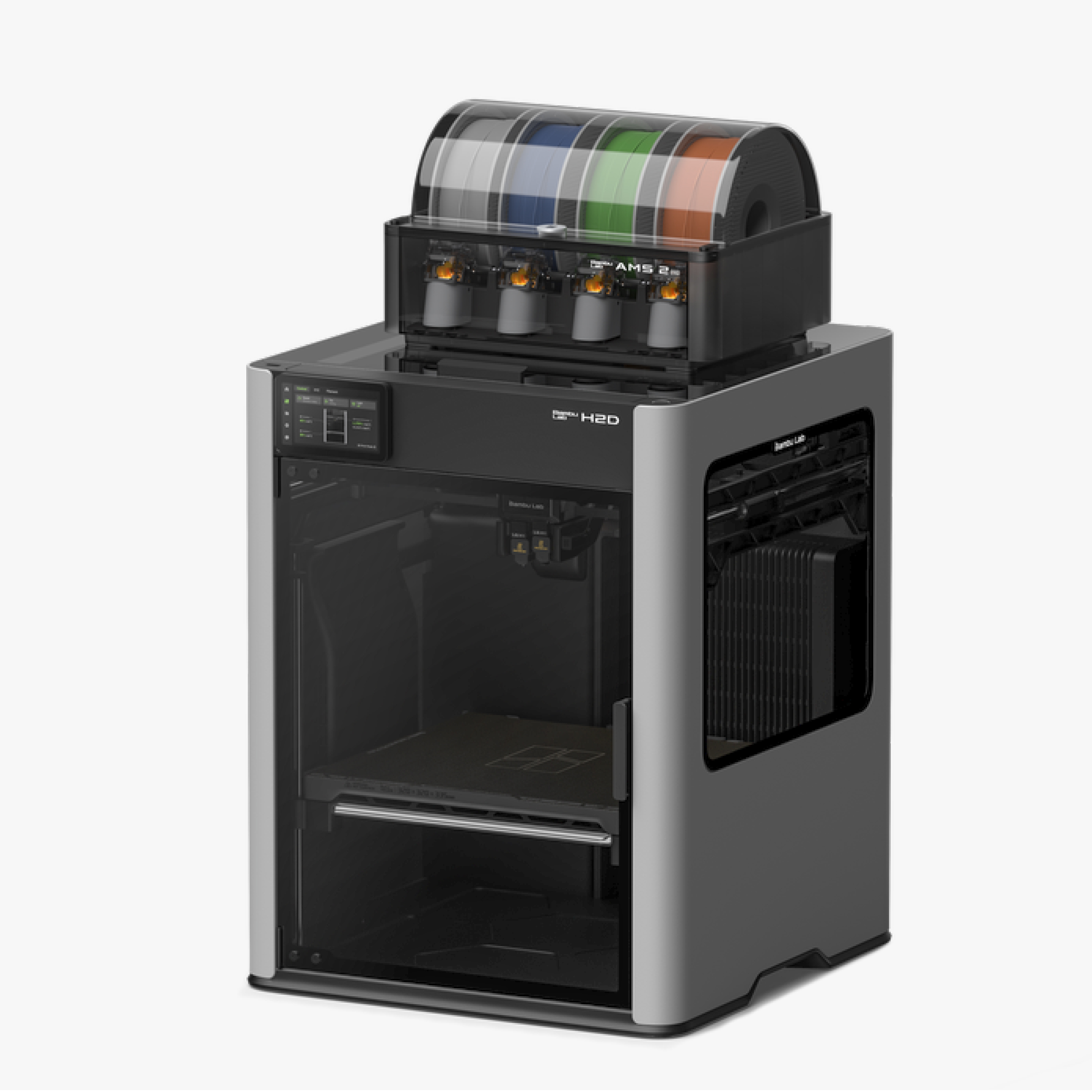Is anything currently more influential in consumer 3D printing than Bambu Lab? Since the 2022 launches of the X1 and X1C, rival manufacturers such as Creality, Elegoo, and Artillery have all rushed to their stationary cabinets, grabbed the tracing paper, and essentially copied what Bambu sprouted. That tells you everything you need to know about what the firm has achieved.
Time punishes those who fail to innovate, however, and Bambu knows that to keep up it has to produce the next big thing. So, come spring ‘25, the firm released its new 3D printer, the H2D.
Bambu Lab says the H2D is an evolution in every aspect, and it does have a point. It’s a larger, faster, more intelligent, feature-packed 3D printer than the X1C – all boxed up with extra toys. Dual extrusion arrives, looking to combat the incredibly high amount of waste produced by X1 series machines. It features a laser engraver, too. As you’ll find out reading on, those are just the headliners.
So, is the H2D a multi-material, multi-discipline match made in heaven? Or is the classic X1C still the pick of the 3D printer pack? Join us for some healthy competition and an answer to the big question – should you upgrade?
The Bambu Lab H2D is a dual extrusion 3D printer that can be scaled up to combine laser cutting, engraving, and plotting. With dual nozzles, a 350 x 320 x 325 mm build volume, and AI-powered precision, it excels in multi-material projects, offering versatility for advanced creators.
Feature Face-Off
Design & Technology
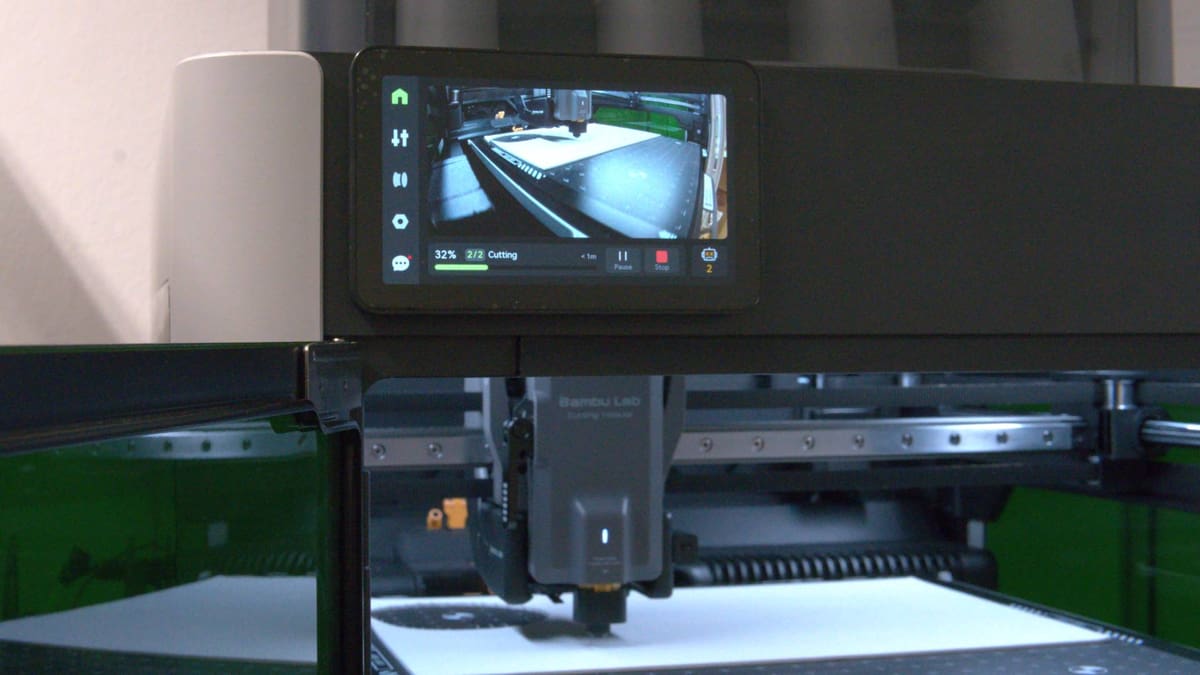
Ok, before we get into the really important aspects of the design, can we all just take a moment to pause and reflect on just how handsome these 3D printers are? This pair could well be the two best-looking 3D printers ever made. Let’s just take a few seconds to enjoy that.
Finished? Ok, onto the real depth in these designs, because they’re far from just a pretty face. These machines are impeccably-presented, highly functional packages.
At the Core
Concealed within sleek silver panels and smart glass doors of both these machines lies a CoreXY movement. Bambu scored huge success with its fast and consistent CoreXY-boosted 3D printing in the X1C. It utilized lightweight carbon fiber rods as rails. They did the job more than well enough, but in the new H2D, Bambu has done away with them, opting instead for linear rails for even greater stability.
It’s stability you’ll need when talking about the speeds the new twin-linked printhead can be flung around at. We’re looking at potentials of 1,000 mm/s of top speed and 20 m/s of acceleration. Users are unlikely to ever see those figures consistently during ownership. The fact remains the machine is capable of them, and additional stability is never a bad thing.

The print bed itself is also pretty fast in its heating. We’ve got the H2D warming up on level pace to the lightning-fast Elegoo Centauri Carbon, a machine that heats up quicker than a U.S. vs Canada hockey clash. Considering the build space, this is a big plus in its favor.
Build space is the lemon cheesecake of 3D printing – no matter how much you have, you’re always likely to want a bit more. Bambu’s cut an extra slice for you in that case, sending the total build volume up from the X1C’s 256 x 256 x 256 mm to a substantially larger 350 x 320 x 325 mm in the H2D. This means the H2D is a larger-than-average unit, though still considered a “medium-sized” 3D printer by our reckoning. That’s not to say it isn’t a little chubster, though: it tips the scales at a touch over 42 kg.
Twin-Linked
As mentioned briefly above, there’s an all-new printhead for the H2D, fitted with a dual-extruder. This confronts one of, if not the biggest, drawback to the X1-series machines – the waste. In reality, this only makes a difference if you’re doing a two-material/color print using both hot ends. You’ll still find the poop-chute used frequently otherwise, particularly if you link an AMS, AMS 2 Pro, or AMS HT. With one of Bambu’s AMS hubs, you can even connect multiple systems, providing a baffling array of on-hand materials and colors.
Let’s be honest, though, the fact you can actually do that is pretty special. A few years ago, that sort of material flexibility in a single consumer printer was but a distant dream.
Those materials need to be fed to the hot ends, of course, and providing that job for the H2D is the new DynaSense extruder. The part actually features a Bambu Lab-built servo motor, something Bambu is keen to point out offers significant advantages, and the data plucked from the new extruder works with the active adjustment flow to offer some of the greatest layer uniformity we’ve ever seen.
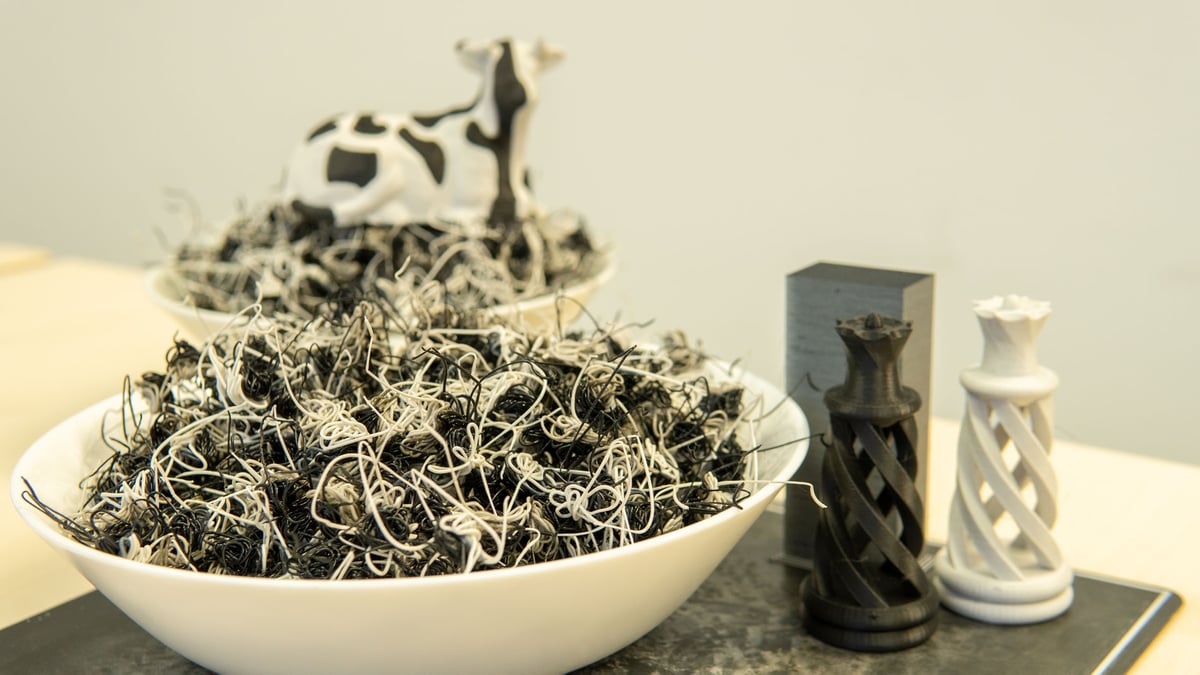
That’s all well and good if the print comes out perfect, but if it doesn’t, it can lead to the amplification of undesirable defects. In actuality, the X1C might be more consistent with its printing, though Bambu’s software-first approach to solving printing problems could mean that the wrinkles we encountered working with the H2D get ironed out relatively quickly. TPU, in particular, has been a real challenge to print on the new H2D.
The H2D and the X1C have enclosed printing chambers, which is great when printing exotic filaments, which can get a bit fussy with drafts and inadvertent temperature changes. Bambu has added an extra level of depth to this enclosed space for the H2D, which has active chamber heating of up to 65 °C. That’s not all, though; it also has what motor racing fans might call “active aero”. The H2D has flaps that will automatically open if a print material is better printed openly (at lower temperatures) instead of being cocooned.
What’s all this green glass for?
You might wonder what the new green glass is for on the H2D. Well, that’s where things really start getting interesting. Bambu offers the H2D with a laser tool now, and the green glass shields you from the sight-robbing beam inside.
Upon ordering, you can opt for one of the packages and bag yourself a 10 or 40 W diode laser toolhead for different prices (more on that later), and that’ll give you the ability to cut and engrave a selection of materials. If you opt for one of the lasers, you’ll also get a pen holder attachment and a cutting module, the latter very handy for creating with papers, vinyl, foams, and fabrics. Make no bones about it, the new H2D is much more of an all-around creator’s machine – and that will be a significant temptation for many people.
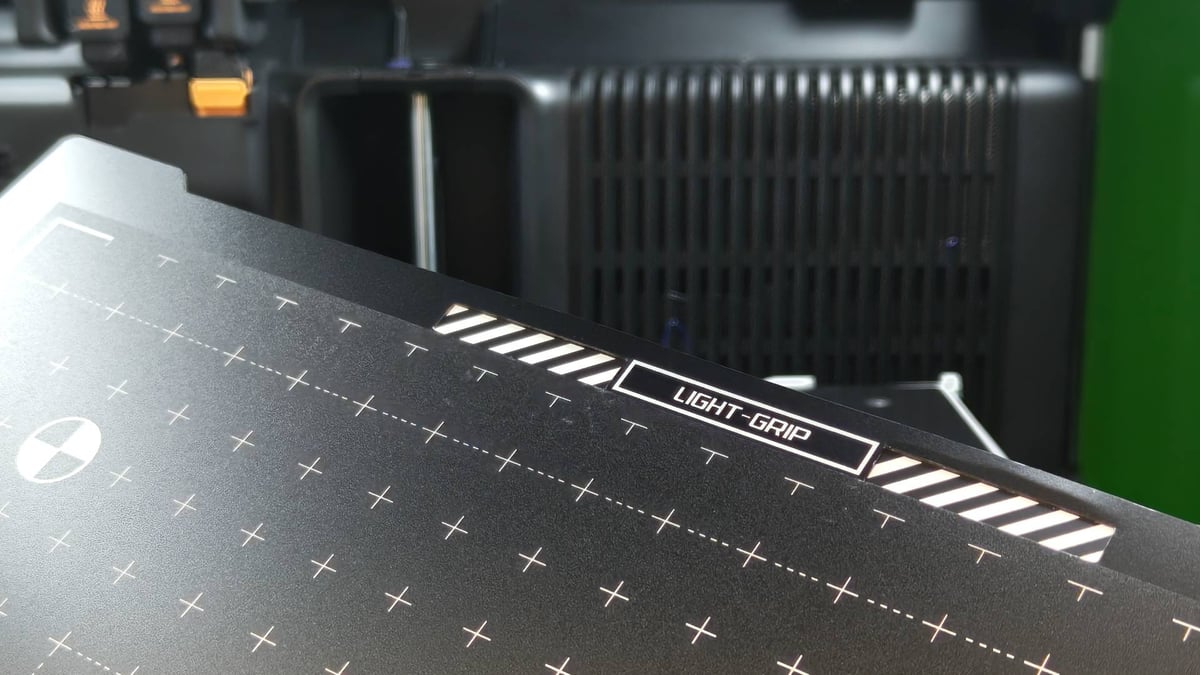
On the topic of the H2D’s toolheads, we have to give praise for the execution of their usability. The heads each mount quickly and interchangeably via a friction-based lever to the existing printhead.
The X1C obviously offers none of the above, and only does 3D printing. That printing however, is up there with the very best, so just how appealing the H2D is as an upgrade much depends on what sort of jobs you need (or want) your machine to do.
In terms of how these functions go about their work, Bambu Lab now has an extra piece of software for the H2D named Bambu Suite. The Suite handles all of the lasering/cutting/drawing business, while the 3D printing is still taken care of by Bambu Studio. Expect a similar software experience in Bambu Suite to the ones you get in something like an xTool or Cricut, in that complexity isn’t likely an issue for most users, regardless of whether or not you’re new to the game.
Price
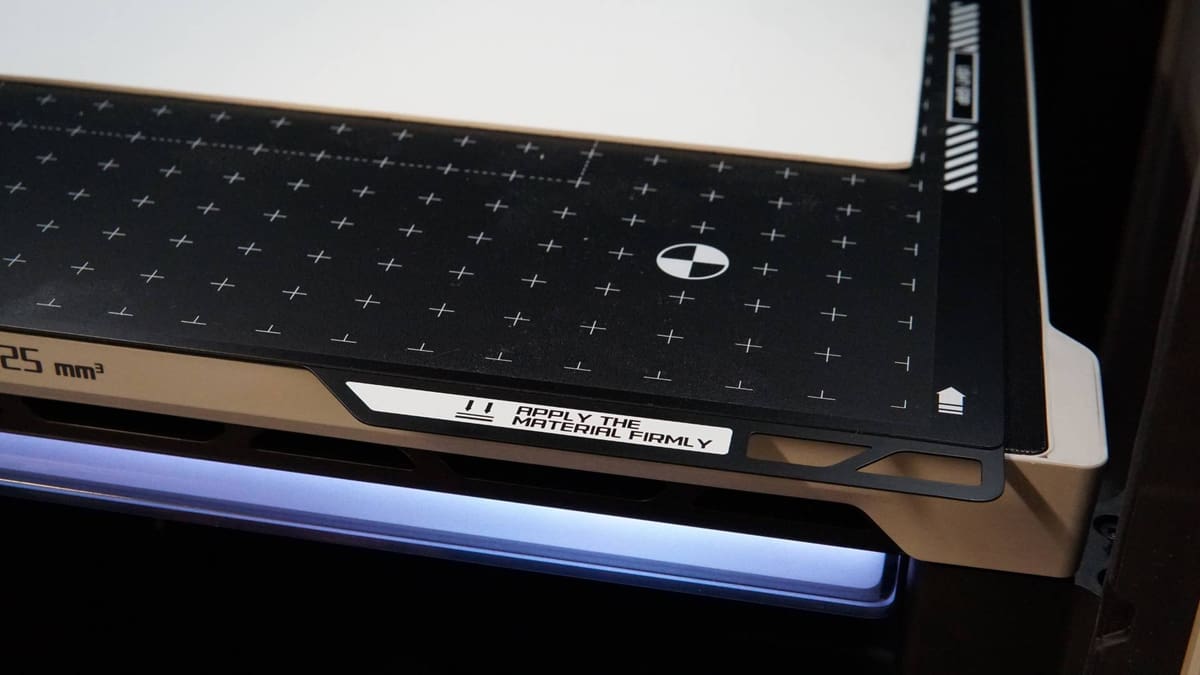
Right, time to talk money. This is now a trickier topic to report on than previously, due to the relatively fluid situation unfolding with the U.S. Government’s new stance on trade tariffs. Note that the information in this section could become outdated quickly, as governments negotiate new trade agreements or adjust policies in reaction to market changes.
During our review of the H2D, prices were initially far lower. We’ve left the prices from that article unedited so you can see for yourselves, but long story short, the H2D is now around $500-1,000 more expensive than just a few weeks ago. That’s at the time of writing in April of 2025. The mid-April 2025 pricing situation is as follows.
The base Bambu Lab H2D (as a pure 3D printer) will set you back $2,399 from June 2025, which is when it should become available to order. That price won’t land you the laser, cutting, or pen plotter tools, and should you add a new AMS Pro 2 to your order, you can add another $300 to that price.
It’s worth pausing for a moment here to point out that if you’ve already bagged an X1C prior to the tariff changes, the H2D is now around double the price of that printer. Ouch.
What about all the new toys?
Thankfully, they come all together, and not in separate bundles. You’ll need to pick the “Laser Full Combo” to obtain them, with a 10 W laser combo setting you back $3,499 and the 40 W landing you an invoice for $4,399. Green glass windows included of course, along with those cutting and pen plotting tools.
Bambu says the laser tools ship in different packages, so don’t panic if you can’t find them in the box with the printer.
Cheap, it is not then. However, that doesn’t mean it isn’t good value for what it is. With the amount of functionality and flexibility crammed into its frame, the H2D provides you with a pile of creative potential. Stocks are expected to be a little low in the short term, but it’s also fair to assume large tariffs will knock out a few potential customers.
Should You Upgrade?

There are some mixed feelings about this in the All3DP editorial lodge. In testing, our printing experience with the new H2D wasn’t as refined as it was with the X1C. TPU was particularly difficult to print with, and now with tariffs biting and the H2D already a more expensive printer, if you already own an X1C, it’s difficult to justify its $2,399 printer-only price tag.
Features like the new dual-extruder, heated chamber, and larger working space are all desirable, but the H2D is now likely to be about double the price you paid for your X1C not all that long ago. It isn’t currently twice the 3D printer that the excellent X1C is.
Oddly though, spending more money on this is easier to justify. 3D printers with multiple creative disciplines (such as 3-in-1s from Snapmaker and Zmorph) are a rare sight, and when they do appear, they can fall a little short of expectations. These machines are often capable of individual processes but masters of none. They’re also expensive and tend to be a bit clunky to use.
We’re yet to flex the H2D’s laser functionality, but from what we’ve seen of the cutting and pen plotting tools so far, we’re impressed. The user experience of switching between creative tech and completing or managing a project is slick and easy to wrap your head around.
Bambu’s software-driven approach to hardware refinement is likely to improve the few frustrations we’ve had 3D printing with the H2D. This could be a fantastic bit of kit for a creator not willing to be bound to printing alone, and if money’s no object it certainly makes sense to opt for the newer over the older machine.
Perhaps for now, it’s better to wait. Keep an eye on the prices and the impact updates will have on the H2D, and think carefully about exactly what it is you want to create.
It’s certainly a fascinating and extremely capable machine, but if you’ve got an X1C, you’ve already got one of the best 3D printers we’ve tested to date.
The Bambu Lab H2D is a dual extrusion 3D printer that can be scaled up to combine laser cutting, engraving, and plotting. With dual nozzles, a 350 x 320 x 325 mm build volume, and AI-powered precision, it excels in multi-material projects, offering versatility for advanced creators.
License: The text of "Bambu Lab H2D vs. Bambu Lab X1C: Should You Upgrade?" by All3DP is licensed under a Creative Commons Attribution 4.0 International License.

